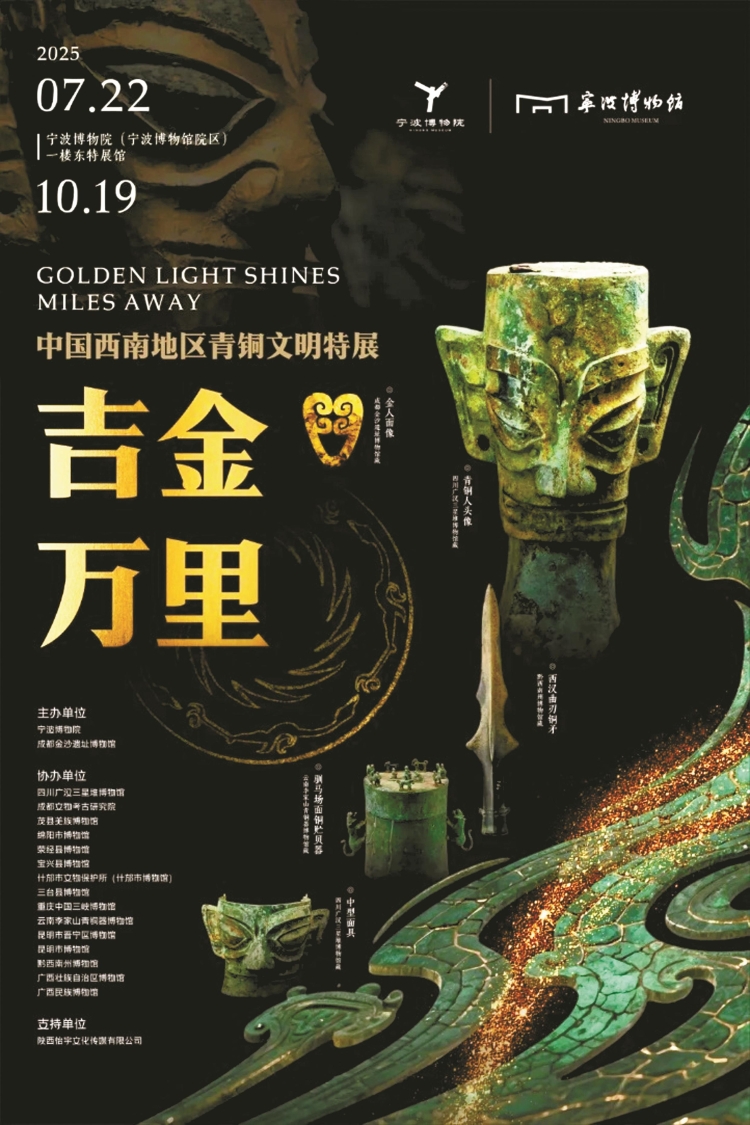
Special Exhibition Poster. (Photo by Huang Yinfeng and Ying Ningyi)
On July 20, Ningbo Museum welcomed a group of precious "guests" — 18 artifacts from the Sanxingdui Museum in Guanghan, Sichuan, including bronze human heads, medium-sized masks, and bronze eye-shaped objects. These mysterious relics from the ancient Shu civilization will be unveiled to the public at the upcoming special exhibition "Golden Lights Shines Miles Away: The Bronze Civilisation of Southwest China," opening on July 22.
Unboxing the Artifacts: Unveiling the Mystical Masks
At 10 a.m., inside the first-floor special exhibition gallery of the Ningbo Museum, staff members carefully unscrewed the bolts of the transport crates and peeled back layers of protective packaging. One by one, the Sanxingdui artifacts began to reveal themselves. Tan Benjun, a cultural relic preservation expert from the Sanxingdui Museum, oversaw the entire process. “Each mask is placed in a custom crate with sponge padding and cutouts matching its shape to ensure maximum protection during transport,” he explained.
Among the 18 artifacts on display from Sanxingdui, 13 are designated as national first-class cultural relics. These include two bronze human heads, medium-sized masks, and bronze eye-shaped items — all excavated from Sanxingdui's Pit No. 2. Their exaggerated forms and distinctive style vividly reflect the ancient Shu kingdom's blend of theocratic and royal authority.
The bronze human heads feature slender faces, large eyes, and pierced ears, possibly for earrings. The medium-sized masks highlight the Shu people's reverence for divine power, with exaggerated ears and wide mouths showcasing the extraordinary imagination of early civilizations.
Exhibition Highlights: Beyond Sanxingdui — A Panoramic View of Southwest China's Bronze Civilization
The "Bronze Treasures Across the Land" special exhibition is co-organized by Ningbo Museum and Chengdu Jinsha Site Museum. It brings together 165 pieces (or sets) of rare artifacts from cultural institutions across Sichuan, Chongqing, Yunnan, Guizhou, and Guangxi. Focusing on the unique characteristics of regional bronze cultures, the exhibition uses archaeological evidence and artistic storytelling to present the creativity of ancient kingdoms such as Ba, Shu, Yelang, Dian, and Ouluo, as well as their interactions with Central Plains civilization.
Xu Qin, Deputy Director of the Collections and Research Department at Ningbo Museum, remarked, “This exhibition offers a much broader perspective, allowing visitors to appreciate the diverse aspects of bronze culture in Southwest China.”
Among the highlights is the Bronze Cow-Shaped Shell Container from the Lijiashan Bronze Museum in Yunnan. The bull on the lid can rotate, reflecting ingenious design — it was not only used for saving money in the ancient Dian Kingdom, but also serves as a three-dimensional record of history. The Four-Spoked Coin-Patterned Bronze Drum from the Guangxi Museum of Nationalities features intricate decorations, echoing the sun-worship motifs seen in Sanxingdui. Another standout is the Ram-Horn Knob Bell from the Qianxinan Prefecture Museum, with a distinctive shape that stands as a testament to the region’s ritual music culture.
After unboxing, the staff gently placed each artifact onto custom mounts, adjusting them for optimal display angles. “Bronze artifacts are highly sensitive to humidity and temperature,” Tan Benjun explained. “Each display case is equipped with climate control to ensure stable conditions during the exhibition.” The lighting design was also carefully planned to avoid direct exposure, protecting the relics’ surface patina.
Southwest China’s bronze civilization, with its rich regional characteristics and cultural depth, shines alongside that of the Central Plains, together forming a brilliant chapter in the story of ancient Chinese bronze culture.
“Since reservations opened, visitor enthusiasm has been high — weekend ticket sales have already surpassed a thousand on some days,” said a Ningbo Museum representative. This cross-regional cultural dialogue promises to offer residents and tourists in Ningbo an unforgettable journey through ancient civilization.
Source: Ningbo Daily
Editor: Ye Ke



